Day 1 in Arles
Welcome to Arles! After checking into your hotel, begin the afternoon in the Place du Forum, one of the main squares with shady plane trees and an ancient past of surrounding Roman ruins. Enjoy some lunch at one of the many restaurants in the area. This is also where you`ll find the famous Café Terrace at Night, which is the spot where Van Gogh painted one of his most celebrated masterpieces.
Afterward, we recommend that you get acquainted with the city by taking a Van Gogh Walking Tour, which will take you to various sites where this `Fauve` artist painted. The tour is an excellent guide to Arles because it shows off the present-day town as well as its Post-Impressionist heritage. Some highlights that are marked: the Trinquetaille bridge where he painted the Staircase of the Trinquetaille Bridge, the Rhône River embankment for his Starry Night over the Rhone, the Place Lamartine where his Yellow House was located, in the Rue Mireille at the Old Mill, the public park on the Boulevard des Lices for his Public Garden, the Espace Van Gogh and his Hospital Garden, the road going along the Arles-to-Bouc Canal at the Langlois Bridge with Washerwomen, more commonly called the `Van Gogh Bridge`.
After touring the city and following the Van Gogh trail, head over to the Van Gogh Foundation. This museum aims to share its passion for the artist and for contemporary art influenced by Van Gogh. The Foundation is in the restored 15th-century Hôtel Léautaud de Donines. As night falls, head out to one of the many great cafes or restaurants in Old Town. The area offers a range of eateries to enjoy, from casual pavement cafes to elegant Michelin starred restaurants.
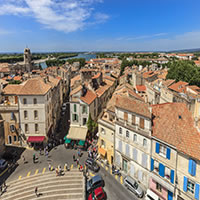
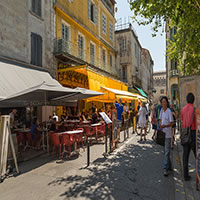
Day 2 in Arles
Start the day off early to explore the city`s most prominent Roman ruins. Begin the day touring the Arles Amphitheater. The theater is located in the center of town and is the most popular destination in Arles. Built in 90 A.D, this two-tier Roman Coliseum has a capacity of 20,000 spectators and is the 12th largest coliseum of the Roman Empire. Roam freely through the corridors of the amphitheater, take in the demonstrations of gladiator fighting, and don`t miss going to the top north tower to see the amazing views of Arles and the Rhône. Make sure to check out a bullfight or gladiator contest while here, these are hosted during certain times of the year.
After seeing the Roman Amphitheater, head over to The Roman Theater, known as the Théâtre antique d`Arles, which was also built near the end of the 1st-Century by Julius Caesar. Only two columns remain of its once magnificent two-story stage. The 33 rows hold up to 10,000 spectators. Unlike its neighbor The Amphitheater, the Roman Theater suffered serious decline during the Middle Ages when it was mined for its marble. Despite the signficant deterioration of the original Theater, it is still used today for concerts and events.
In the afternoon, head over to Place de la Republique situated in the center of Arles and home to the ornate town hall. Here you will find the famous St. Trophime Church with its impressive Cloister, St Anne Chapel. St. Trophime Church dates back to the 12th-century and was an important place of pilgrimage in the Middle Ages. It`s Cloisters is widely considered by art historians to be the most beautiful in all of the France.
As evening approaches, we suggest staying in Place de la Republique where you will find several shops in the area to stroll around in.There is a beautiful fountain in the center of the square and some great restaurants to sit and enjoy watching the world go by.
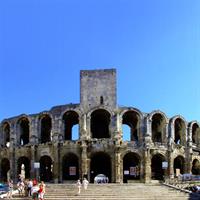
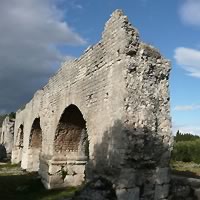
Day 3 in Arles
Make your way to the Thermes de Constantin - the Roman baths of the Emperor Constantine, located near the banks of the Rhone river. Built in the 4th-century, they were once part of the grand imperial palace. Today they include the Caldarium (warm bath) and parts of the Hypocaust (under floor heating) and the Tepidarium (warm air room).
Alternatively, if you are here on a Wednesday or Saturday, spend the morning shopping around Arles market. You`ll find plenty of fresh local produce, clothing and shoes, and arts and crafts. The main market is held on Saturday mornings and is a big affair covering 1.2 miles. The smaller market is held on Wednesday mornings on Boulevard Emile Combes.
Spend the rest of the day at the Camargue, the delta formed where the Rhone River flows into the Mediterranean Sea. The 360 square mile marshland was made a National Park in 1970 and declared a `Wetland of International Importance` in 1986. It`s famous white horses, black bulls, 400+ species of wild birds, small villages, and general lack of tourists make it a wonderful destination that is only 6 miles south of the city center of Arles.
On your final night, head over to the Hotel Nord Pinus. Have a drink or enjoy dinner at the hotel where Picasso once slept and bull fighters favored. The 4-star hotel comes complete with two embedded Corinthian pillars from the Roman temple that was once part of the ancient Roman Forum.


Additional Days in Arles
Should you be able to spend additional days in Arles, we suggest you take a day trip to Nîmes. Two thousand years ago, Nîmes was an important stop on Roman trading road Via Domitia (and it shows). Today, the city has an attractive urban center which includes parks and ancient Roman architecture. While here, make sure to check out the Les Arènes, a Roman amphitheater constructed during the first century AD. The complex is composed of two rings of 60 arches, measuring 69 ft. Take a guided tour to discover the events that took place here in the ancient times.
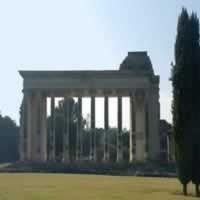
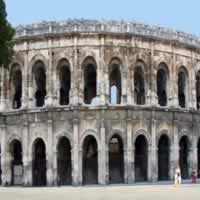
Your Last Day In Arles
Depart your hotel for the airport or train station where you will head home or make your way to more European adventures. Savor the memories of a special time in Arles in the south of France.
